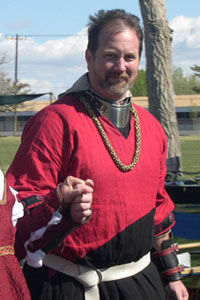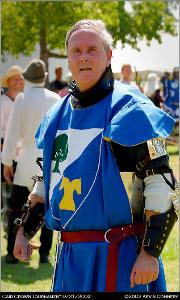 I chose a Terza Rima for Sir Dante, invented by the 13th century Italian poet of the same name for his epic poem, The Divine Comedy.
I chose a Terza Rima for Sir Dante, invented by the 13th century Italian poet of the same name for his epic poem, The Divine Comedy.
Terza Rima is composed of tercets woven into a rhyme scheme that requires the end-word of the second line in one tercet to supply the rhyme for the first and third lines in the following tercet. Thus, the rhyme scheme:
a b a
b c b
c d c
d e d
continues through to the final stanza or line.
Terza rima is typically written in an iambic line, and in English, most often in iambic pentameter.
————-<>————-
Sir Dante Lizza da Benevento
fallen in Spring Crown Tourney, A.S. XLII
(terza rima)
Atop the rolling hills Her finest came
To place the wreath of roses on Her hair
And share with Her the triumph of the game.
For most, the sun’s warm rays would burn and glare
But under mighty oaks this warrior stood
Each gallant blow a victory for Her Heir.
He met the list with all the might he could
Until another son would have his way
And bring the tourney’s end to, as it should.
For all who saw this tournament display
There was no nobler knight than he who fell
And victory was Hers upon this day.
— THL Beathog nic Dhonnchaidh
. . . a 14th century bard who can often be seen traveling far from her home in the Highlands with her lord husband and muse. If a good tale crosses her path, she will sing a song about it, pull out its hair and spin it, or throw it in a pot and cook it up.





